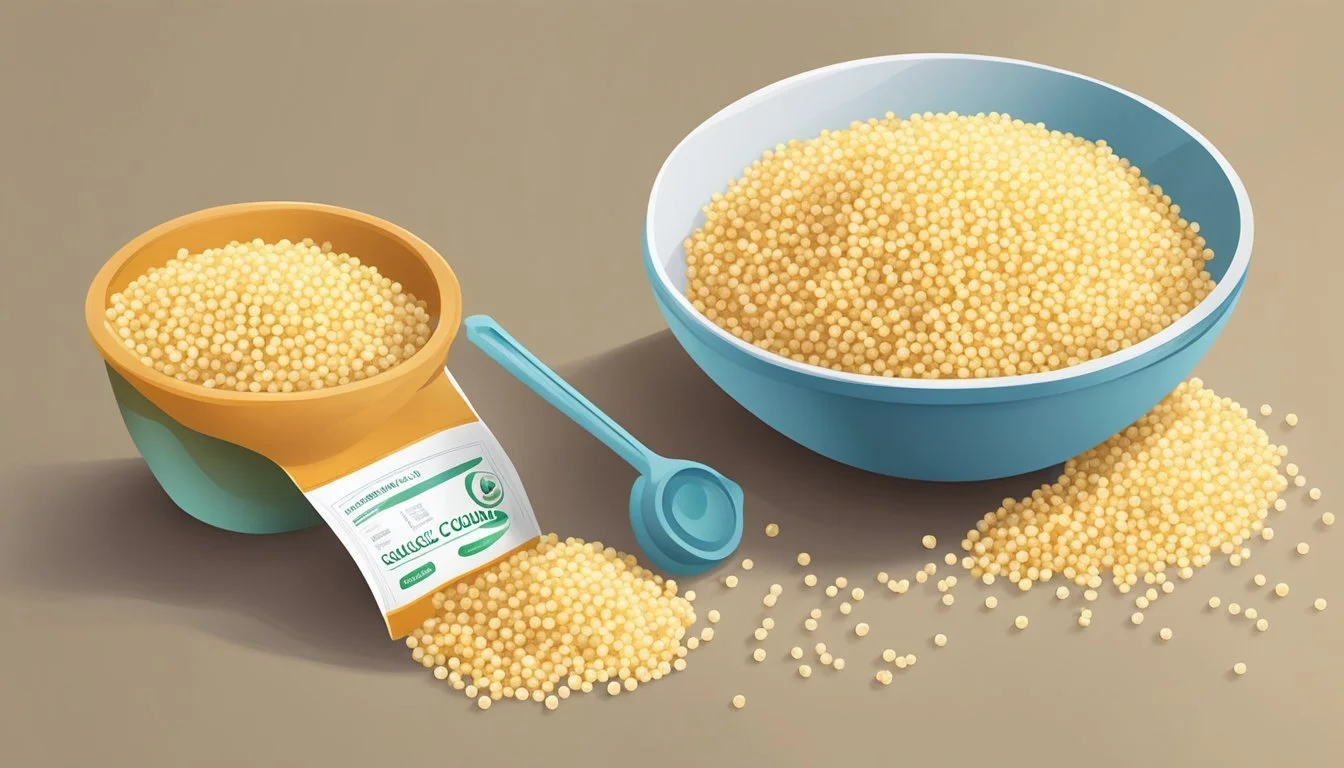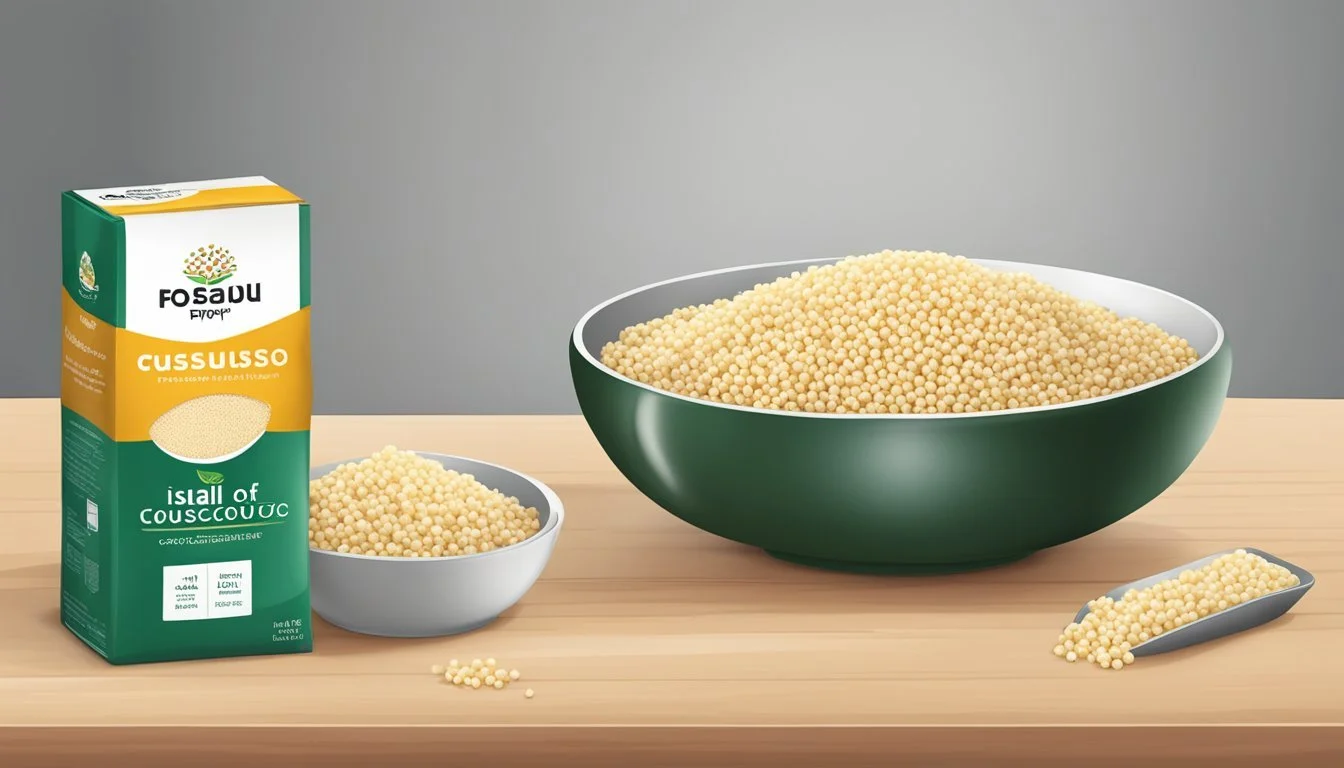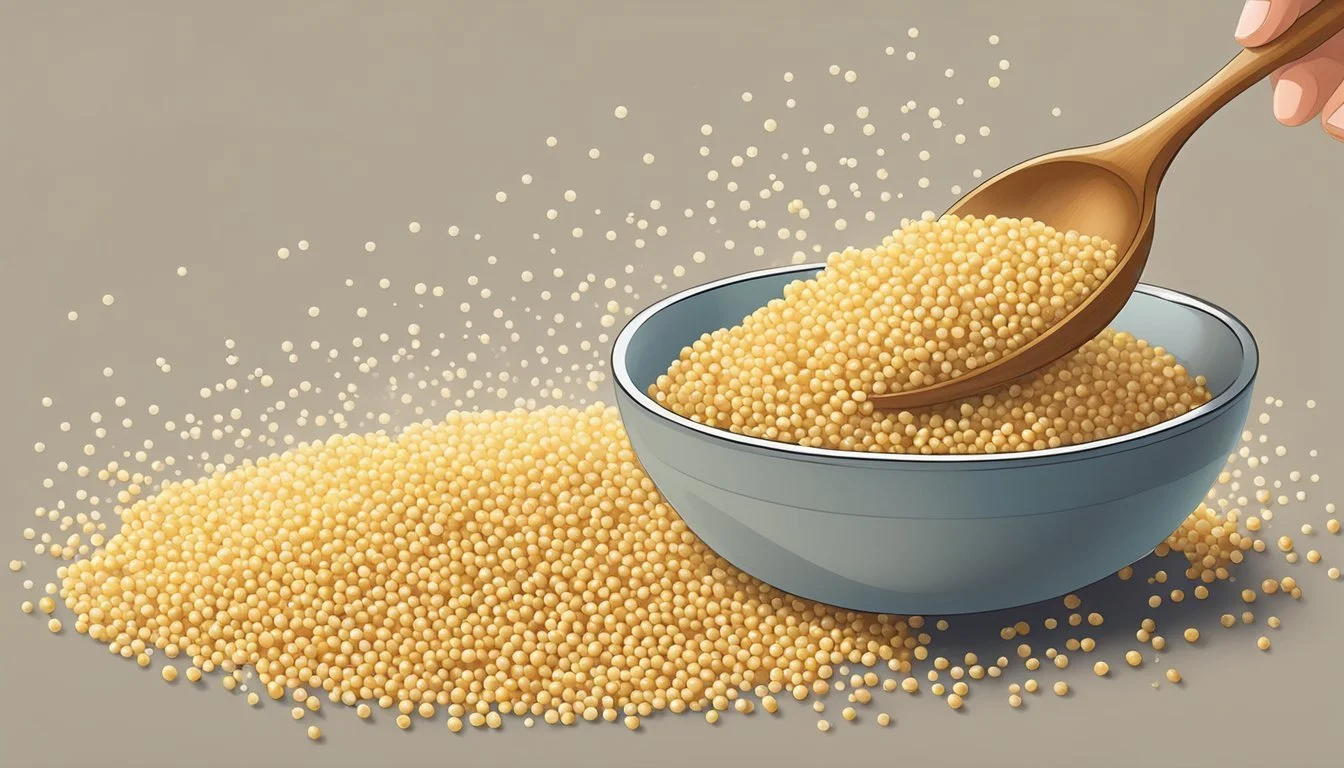How to Substitute Israeli Couscous for Regular Couscous
A Simple Guide
Israeli couscous (What wine goes well with couscous?), also known as pearl couscous, offers an intriguing alternative to regular couscous, with its larger, chewier pearls and nutty flavor. As a toasted pasta made from wheat flour, it has roots in Jerusalem cuisine and differs markedly from the smaller, granular North African couscous most are familiar with. The two types differ not only in size but also in texture and cooking method, making the substitution process one that requires a slight adjustment in preparation.
When considering a substitute for regular couscous, it is important to recognize that while both can often play similar roles in recipes, Israeli couscous will lend a distinct mouthfeel and may alter the final taste profile of the dish. Offering a gluten-free alternative, quinoa (What wine goes well with quinoa?) often comes up in discussions around couscous substitutes—boasting a complete protein profile and a grain-like behavior in recipes—though its flavor and consistency contrast with both Israeli and regular couscous.
Navigating the substitution of Israeli couscous for its smaller cousin entails understanding these differences and how they may influence the harmony of the ingredients within a given recipe. Cooking Israeli couscous involves simmering in broth or water until tender, a technique that produces its characteristic al dente texture, whereas regular couscous usually requires a simple addition of hot water or steam to fluff up the grains. This fundamental step ensures any adaptation of recipes traditionally calling for regular couscous takes into account the unique qualities of the Israeli variety.
Understanding Couscous
Couscous is a versatile staple in many cuisines, known for its quick cooking time and ability to absorb flavors well. It comes in various sizes, each with a distinctive texture and culinary use.
Types of Couscous
Traditional couscous, often made from semolina derived from durum wheat, is the smallest in size and fastest to cook. It typically has a light, fluffy texture when prepared. Israeli couscous, also known as pearl couscous or 'ptitim', stands out with its larger, rounder beads. Created in the 1950s, Israeli couscous is toasted, giving it a nuttier flavor and chewier texture compared to its smaller counterpart. Israeli couscous takes longer to cook and can serve as a direct substitute for rice due to its size and shape.
There are also types made from other grains like barley, which offer a different flavor profile and may have varying nutritional benefits.
Nutritional Profile
When examining the nutritional content of couscous, it is notable that both traditional and Israeli couscous contain protein and fiber, although the amounts may vary slightly based on the type and the specific grain used.
Traditional couscous typically offers:
Fiber: Promotes digestive health and can help in maintaining blood sugar levels.
Protein: Vital for muscle repair and overall bodily functions.
Calories: Primary energy source; amounts depend on serving size.
Carbohydrates: Main source of energy for the body.
Fat: Usually low in fat content.
Israeli couscous generally provides a similar nutritional profile but with subtle differences due to its larger size and processing method. For example, it might offer slightly more calories per serving due to its density.
Here's a simplified nutritional comparison table for a typical serving of each:
Nutrient Traditional Couscous (per 100g) Israeli Couscous (per 100g) Calories Roughly 112 Around 120 Protein Approximately 4g About 4.2g Fiber About 2g Commonly 2.2g Fat Roughly 0.2g Close to 0.4g Carbohydrates Around 23g Typically 25g
It’s important to note that the cooking method and additional ingredients can alter the nutritional values of both types of couscous.
Israeli Couscous Basics
Israeli Couscous, also known as pearl couscous or ptitim, is a versatile ingredient that offers a unique texture and size difference compared to traditional couscous. Understanding its characteristics and cooking method is essential for substituting it successfully.
Characteristics of Israeli Couscous
Israeli couscous, sometimes referenced as pearl couscous or ptitim, is a type of pasta with small, round, and slightly chewy texture. Unlike traditional couscous, which is tiny and granular, Israeli couscous is larger in size, resembling little pearls. Made from semolina flour, it is rolled into small balls, which are then toasted, giving Israeli couscous its distinct nutty flavor and robust texture. Unlike regular couscous, which tends to absorb flavors readily, Israeli couscous provides a more neutral base, allowing it to complement a wide range of dishes.
Cooking Israeli Couscous
When cooking Israeli couscous, the process begins with boiling water. Generally, a ratio of 1 1/2 cups of water to 1 cup of couscous is recommended. First, the couscous is often sautéed lightly in olive oil until it takes on a golden color. Then, boiling water is added to the couscous, and the combination is brought to a simmer. The couscous should be cooked until it is tender and all the liquid has been absorbed. This usually takes about 10 to 14 minutes. Once done, the couscous should be fluffy and not sticky, making it an excellent substitute for regular couscous in various recipes.
Regular Couscous Preparation
The preparation of regular couscous is a straightforward process that yields a light and fluffy side dish. This section outlines the practical aspects of cooking regular couscous and its common uses.
How to Cook Regular Couscous
Regular couscous, often referred to as Moroccan couscous, is made from semolina which is granules of durum wheat. The traditional method of cooking involves boiling water, broth, or a seasoned liquid and then incorporating the couscous. A general ratio is one and a half cups of liquid to one cup of couscous.
Steps for Cooking:
Boil the liquid: Bring water or broth to a boil in a saucepan. Optionally, add olive oil or butter and a pinch of salt for flavor.
Add couscous: Once the liquid is boiling, stir in the couscous.
Remove from heat: Take the saucepan off the heat and cover it with a lid.
Let it stand: Allow the couscous to steam for about 5 minutes.
Fluff with a fork: After the couscous has absorbed all the liquid, use a fork to fluff it up, breaking any clumps to achieve a light and fluffy texture.
Common Uses for Regular Couscous
Regular couscous is a versatile ingredient in Moroccan and Mediterranean cuisine. It's often served as a side dish and can be flavored with a variety of herbs, spices, or vegetables.
As a base: It can act as a base for stews and grilled meats or vegetables.
In salads: Cooled couscous is frequently added to Mediterranean salads for texture and substance.
In soups: It's also used in soups where it absorbs the flavors of the broth and provides a satisfying bite, akin to an al dente pasta.
It’s important to rinse regular couscous before cooking to remove any excess starch which prevents sticking and ensures the grains remain separate.
Substituting Israeli Couscous
When substituting Israeli couscous for regular couscous, one must consider differences in grain size, cooking times, and texture. The larger pearls of Israeli couscous require modifications in both preparation and cooking method to achieve the desired consistency and flavor profile.
Adjusting Cooking Times
Israeli couscous, with its larger, chewier pearls, inherently requires a longer cooking time than its smaller counterpart. Typically, regular couscous needs about 5-10 minutes to absorb boiling water, while Israeli couscous must be boiled and then simmered.
Boil Israeli couscous in water (or broth for added flavor) for about 6-8 minutes.
After boiling, reduce the heat and allow the couscous to simmer for an additional 12-15 minutes until it reaches a chewy texture.
Ensure the pearls have absorbed the liquid adequately and fluff them with a fork.
Adapting Recipes for Substitution
To integrate Israeli couscous into recipes calling for regular couscous, adjustments in liquid ratios and seasoning may be necessary. The objective is to allow the robust pearls to fully absorb the flavors of the dish.
Increase the liquid slightly, as Israeli couscous tends to absorb more than regular couscous.
Adjust the seasoning, accounting for the increased volume and texture of Israeli couscous, which can impact the overall flavor profile.
When done correctly, Israeli couscous can be an excellent substitute in recipes, offering a pleasant, al dente texture that can enhance a variety of dishes.
Recipe Variations With Israeli Couscous
Israeli couscous, also known as pearl couscous, provides a versatile base for a variety of dishes. Its larger size and chewier texture compared to traditional couscous make it an excellent substitute, adding a twist to familiar recipes.
Salads and Cold Dishes
Israeli couscous salads bring a delightful texture to classic cold dishes. Here’s a simple approach:
Couscous Salad: Combine 1 cup cooked Israeli couscous with chopped vegetables like tomatoes, cucumbers, and onions. Dress with a mixture of lemon juice, olive oil, salt, and pepper to taste. Enhance the flavor with fresh herbs like parsley and mint. This dish can serve as a refreshing side or a light vegetarian meal.
Tabbouleh Twist: Substitute Israeli couscous for bulgur wheat. Mix it with finely chopped tomatoes, parsley, mint, onion, and a dressing of lemon juice and olive oil. Bold spices such as cumin can be added for depth.
Warm Dishes and Entrées
The sturdier texture of Israeli couscous makes it ideal for incorporating into warm entrées:
Substitute for Rice: In any dish calling for rice, use Israeli couscous as a substitute for a nuttier, heartier alternative.
Dish Preparation Instructions Risotto Sauté couscous in olive oil, add broth gradually. Stuffed Peppers Fill with couscous, spices, vegetables, and bake.
Robust Side Dishes: Israeli couscous can absorb rich sauces without losing its integrity, making it perfect for saucy dishes.
Israel couscous dressed in a savory sauce or combined with sautéed vegetables such as zucchini and celery can be a complete side dish. It absorbs flavors well, complementing spices and aromatic ingredients used in cooking.
Seasoning and Flavor Enhancements
When substituting Israeli couscous for regular couscous, accentuating flavors with the right seasonings and fresh ingredients can elevate the dish to new culinary heights. Using herbs and spices judiciously pairs well with the couscous's neutral palate, allowing for a harmonious blend of aromas and tastes.
Herbs and Spices
Israeli couscous benefits greatly from the inclusion of a variety of herbs and spices, which can be tailored to complement the specific dish being prepared.
Salt: Using kosher salt is the standard for seasoning, enhancing the natural flavor without overpowering the dish.
Pepper: A touch of black pepper adds a mild heat and sharpness.
Aromatic Herbs: Freshly chopped parsley, dill, mint, cilantro, and basil contribute vibrant, fresh flavors.
Dry Spices: Ground cumin and thyme offer earthy and subtle woodsy notes.
One can adjust the quantities to suit personal preferences and the particular recipe requirements.
Additional Ingredients
Beyond herbs and spices, various ingredients can be incorporated to complement the base flavor profile of Israeli couscous.
Oils: Extra virgin olive oil not only aids in the toasting process but also imparts a fruity, peppery background note.
Acids: A splash of lemon juice can brighten the overall flavor palette, bringing a zesty freshness to the dish.
Aromatics: Garlic, when used sparingly, brings a distinctive aroma that doesn't overwhelm other flavors.
Vegetables: Fresh cherry tomatoes offer a juicy, sweet contrast that pairs excellently with the grain's texture.
These ingredients should be used with intention to create a well-rounded, flavorful dish that showcases the versatility of Israeli couscous.
Serving and Pairing Suggestions
When choosing to substitute Israeli couscous for regular couscous, one should consider the texture and taste of the larger pearls, which pairs well with a variety of side dishes. This section will guide through selecting complementary accompaniments and integrating Israeli couscous into meal plans.
Accompaniments and Side Dishes
Israeli couscous, with its chewy texture and mild taste, serves as an excellent base for a plethora of side dishes. They may include vegetables such as tomatoes, cucumbers, and olives. A mix of these with feta cheese and fresh parsley can create a refreshing side salad. Here's a simple suggestion:
Vegetable Mix:
Diced cucumber
Halved cherry tomatoes
Sliced Kalamata olives
Crumbled feta cheese
Chopped fresh parsley
Further richness can be added with the inclusion of various nuts for a crunchy texture. Finish the dish with a light dressing of olive oil and lemon juice for a balanced flavor.
Integrating into Meal Plans
Israeli couscous can be incorporated into meal plans as a satisfying base that complements a variety of proteins like chicken. For a balanced entrée, pair it with a crispy chicken schnitzel and a side of roasted vegetables. Alternatively, one might opt for a more Mediterranean flair, adding fruit such as pomegranate seeds for a sweet and tangy twist. The inclusion of Israeli couscous adheres well to meal prepping, being easy to store and reheat, providing a quick and nutritious addition to weekday meals.
Nutrition and Dietary Considerations
When considering a substitution between regular couscous and Israeli couscous, it's important to assess their nutritional profiles and how they align with dietary restrictions.
Calorie and Macronutrient Comparison
Regular Couscous:
Calories: Approximately 176 per 1 cup cooked
Protein: 6 grams
Carbohydrates: 36 grams
Fiber: 2 grams
Fat: 0.25 grams
Iron: Provides about 1% of daily value
Israeli Couscous:
Calories: Approximately 200-220 per 1 cup cooked
Protein: 6-7 grams
Carbohydrates: Approximately 40 grams
Fiber: Less than regular couscous
Fat: Slightly higher than regular couscous
Iron: Varies based on fortification and brand
Both types provide essential B vitamins and minerals like phosphorus and magnesium. However, regular couscous tends to be lower in calories and can offer slightly more dietary fiber per serving.
Dietary Restrictions
Dietary restrictions can influence the choice between Israeli couscous and regular couscous. For individuals following a gluten-free diet, neither regular couscous nor Israeli couscous is suitable as both are made from wheat. Those monitoring sodium intake should check the labels of packaged couscous, as some varieties may have added sodium.
Inclusions of each type in restricted diets may vary:
Low-fat diets: Regular couscous typically contains less fat.
Iron requirements: Some brands of couscous may be fortified with iron, while others are not. It is essential to check nutrition labels for exact iron content.
Gluten intolerance or celiac disease: Alternative grains like quinoa may be a better option, as it is naturally gluten-free.
Individuals with other specific dietary needs should compare the labels of both couscous types to make the best choice for their nutrition goals.
Storage and Food Safety
Proper storage practices ensure that both Israeli and regular couscous retain their ideal texture and are safe to eat. This is crucial as proper storage helps to preserve the quality of the couscous while extending shelf life.
Storing Cooked and Uncooked Couscous
Uncooked Couscous:
Israeli Couscous: It should be stored in a cool, dry place in an airtight container. It can last about 1 to 2 years if stored properly.
Regular Couscous: Similarly, store in a cool, dry place away from moisture and heat. Its shelf life can also extend to 1 to 2 years under optimal conditions.
Cooked Couscous:
Both Israeli and regular couscous should be cooled down to room temperature before storing to prevent moisture build-up.
Store in the refrigerator in a tightly sealed container to keep out moisture and other contaminants. It is generally recommended to eat cooked couscous within 3 to 5 days.
Avoiding Common Mistakes in Storage
Prevent Moisture: Both types of couscous can become mushy if exposed to moisture. Ensure containers are dry before use.
Separation: Cooked couscous should be fluffed with a fork to prevent clumping and encourage separation before storage.
Temperature Safety: Don’t leave cooked couscous at room temperature for longer than 2 hours to reduce the risk of bacterial growth.
Alternative Grains and Substitutes
When looking for substitutes for regular couscous, one can consider both gluten-free options and grains with similar textures. Each alternative provides a unique flavor profile and nutritional benefits that cater to different dietary needs.
Gluten-Free and Whole Grain Options
For individuals with gluten sensitivities or who prefer whole grain options, several alternatives provide comparable textures and flavors to regular couscous:
Quinoa: A protein-rich seed that's gluten-free and cooks up fluffy like couscous.
Preparation: Ratio of 1:2 quinoa to water, simmer for 15 minutes.
Brown Rice: Offers whole grain benefits and a chewier texture.
Preparation: Ratio of 1:2 rice to water, simmer until tender.
Bulgur: Although not gluten-free, it's a whole wheat grain with a similar quick cooking time to couscous.
Preparation: Ratio of 1:2 bulgur to boiling water, let stand until absorbed.
Similar Grain Substitutions
Grains closely mimicking the texture and size of regular couscous enable seamless substitution in recipes:
Orzo Pasta: A rice-shaped pasta made from wheat flour that can be used as a direct substitute for couscous.
Preparation: Boil in salted water until al dente, typically 8-10 minutes.
Pearl Barley: This grain offers a heartier chew and is best for recipes that can accommodate a slightly different texture.
Preparation: Ratio of 1:3 barley to water, simmer for 30-40 minutes.
Semolina Flour: While not a whole grain, it's a product of durum wheat and can be used as a base to make homemade couscous if preferred.
Preparation: Often used in making fresh pasta (how long does fresh pasta last?) or as a thickening agent.
When substituting, consider the cooking time and liquid absorption rate as they can differ from that of regular couscous. This consideration is vital to maintain the intended texture and consistency of the dish.










